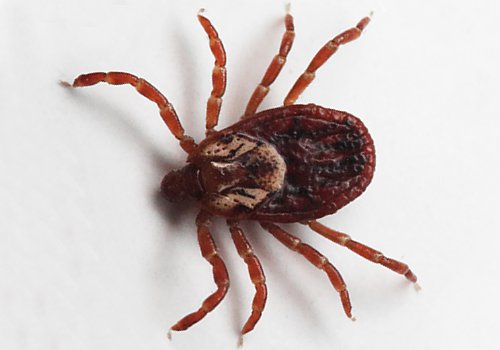 (source)
(source)
|
Howard T. Ricketts
(9 Feb 1871 - 3 May 1910)
American pathologist who discovered the role of ticks in the transmission of Rocky Mountain spotted fever. He died at age 39 from contracting typhus, the disease he was then investigating.
|
Rocky Mountain Spotted Fever
A paper by Howard T. Ricketts (1907)
[Howard Ricketts died from being infected by typhus, the disease he was investigating after his successful work on Rocky Mountain spotted fever. Shortly after his death, as a tribute to his memory, the Chicago Pathological Society organized the publication of a collection reprinting his articles on these diseases and his earlier work on blastomycosis. The committee recognized the great importance of his work, Despite a career cut short by an early death, and although several of his research papers were omitted, the book still ran to 497 pages in length. One example of Ricketts' careful work is reproduced here.]

H. T. Ricketts.
(From the Pathological Laboratory of the University of Chicago.)
[p.333] In the Medical Sentinel (Portland, Ore.) for October, 1899, Dr. Edward E. Maxey, of Boise City, Idaho, called attention to “the so-called spotted fever of Idaho.” He described it as “an acute, endemic, non-contagious, but probably infectious, febrile disease, characterized clinically by a continuous moderately high fever, severe arthritic and muscular pains, and a profuse petechial or purpuric eruption in the skin, appearing first on the ankles, wrists, and forehead, but rapidly spreading to all parts of the body.” The disease is not to be confused with typhus fever nor epidemic cerebrospinal meningitis, to both of which the term spotted fever is sometimes applied.
Rocky Mountain spotted fever is not limited to Idaho, however, but occurs also in western Montana, Utah, Nevada, Oregon, Colorado, Wyoming, and perhaps in other neighboring states. The conditions in the Bitter Root Valley in western Montana aroused such concern that Dr. Louis B. Wilson and Dr. William M. Chowning, then of the University of Minnesota, undertook an investigation in 1902.2 They learned that the disease occurs only during the spring and early summer, and that the eastern side of the Bitter Root Valley is free from infection. They also announced the discovery of an erythrocytic parasite, Piroplasma hominis, as the cause of the disease and promulgated the tick-gopher hypothesis. According to this hypothesis the gopher is the habitual host for Piroplasma hominis, and spotted fever is conveyed from the gopher to man by means of the bite of the wood-tick (Dermacentor occidentalis), which feeds on both man and animals. It [p.334]was stated that Piroplasma hominis exists in about 20 per cent of the gophers from the infected side of the valley but was not found in those from the east side. They furnished no experimental evidence in favor of the tick theory.
Anderson,3 and later Stiles,4 of the Hygienic Laboratory, also studied the disease, the former advocating the tick theory, whereas Stiles discredited it and failed to identify Piroplasma hominis. Neither performed experiments bearing on the tick theory.
Hence when I began my investigations in the Bitter Root Valley in April, 1906, the tick theory was little more than a hypothesis, supported only by the coincidence of the season of the adult tick with that of spotted fever, and the almost constant history of tick wounds shortly preceding the onset of the disease. Furthermore, the validity of the latter point was considered questionable in some quarters, inasmuch as a great many people are tick-bitten every spring without suffering from spotted fever as a consequence. Although this circumstance would not render the tick theory untenable it has caused a great deal of local prejudice against it. Locally there is a strong disposition to attribute to the water of certain streams the power of carrying the poison to man, presumably from foci of decaying vegetation. It is not necessary in this place to go into detail regarding the conditions which a priori lent to the water theory a degree of plausibility.
Since the study of spotted fever had hitherto been limited to the season during which man is attacked it appeared of great importance to discover susceptible laboratory animals, if possible, in order that experimental work might proceed without serious interruption. As the result of investigation it was soon determined that the guinea-pig and monkey (Macacus rhesus) are highly susceptible, that rabbits are almost non-susceptible, and that rats and mice exhibit no outward sign of illness when infection is attempted.5
The following points are taken as proof that the disease reproduced in these animals is spotted fever: (1) The incubation period approximates that in man in so far as it has been ascertained in [p.335] the case of man; (2) the course of fever, the eruption and anatomic changes found at autopsy correspond closely with these features in man; (3) as in the case of man it has not been possible to cultivate a micro-organism from the blood or organs of typical cases; (4) indefinite transmission from animal to animal appears to be possible (100 generations).
Inasmuch as the disease was conveyed to the latter by inoculating them with the blood of human patients, and since it can be transmitted indefinitely from animal to animal in this way by means of the blood, two very important points regarding the nature of the disease are thereby established: First, that the disease is caused by a virus which is capable of propagation, a living organism, for otherwise the consecutive inoculation of 100 generations of animals would not have been possible; second, spotted fever is a systemic or generalized infection, since the circulating blood is invaded by the micro-organism. Inoculation experiments, performed later, showed that all the important organs of diseased animals are heavily infected.6
Further experiments relating to the distribution of the virus among the blood elements showed the following:7
1. The cell-free serum of infected blood contains large amounts of the virus.
2. The virus is present in considerable quantities in an artificially induced leukocytic exudate, free from erythrocytes, and also in the overlying fluid from such an exudate after the cells have been sedimented by centrifugation.
3. Prolonged centrifugation of serum does not free the overlying portion from the virus.
4. It is impossible to free the blood cells in defibrinated blood from the virus by ten to twelve washings with physiologic salt solution, although this process decreases the virulence of the blood. During the washing a point is reached at which the fluid used in washing no longer contains the virus in infective quantities.
It was hoped that experiments of this nature might bring out evidence in favor of or against the piroplasma theory of Wilson and Chowning. I believe, however, that the results do not [p.336]justify positive conclusions for or against this theory. In the experiments cited above the cell-free serum proved rather highly infective; this event, however, does not preclude the possibility of a piroplasmatic infection, for, although piroplasmas invade the erythrocytes extensively in all known piroplasmic diseases, it is self-evident that the plasma must be the medium through which the organisms reach the erythrocytes. Hence in all piroplasmoses there must be many extracellular organisms at some stage of the disease.
Similarly the result quoted above in paragraph 2 does not of necessity disqualify the piroplasma theory, nor does it support strongly the possibility of a predominant leukocytic invasion by the parasite.
The results stated in paragraph 4 would seem to point rather significantly to an intimate relation between the virus and the red or white cells. However, this does not of necessity imply an intracellular location of the parasite, for it is conceivable that the microbes may adhere to the surface of the blood cells either through mutual viscosity or some other attractive or adhesive force. I obtained no positive result in attempting to liberate the organism from its hypothetical position within the blood cells, by crushing the latter in a porcelain ball-mill. This procedure decreased the virulence of the blood, which probably was due to the crushing of many of the organisms in the mill.
In brief, this method of experimentation does not give results which speak conclusively for or against the intracellular location of the parasite, and for this reason, if for no other, the experiments may have some worth.
That the microbe is either very small or of low specific gravity is suggested by the result stated above in paragraph 3.
I have made many attempts to pass the virus as it exists in serum through the porous Berkefeld candle filters, the serum being diluted as much as ten-fold with physiologic salt solution. In no instance has the virus passed through the filters, at any rate in infective quantities, although nine cubic centimeters of serum were used in one experiment. The failure of such a large quantity of filtered serum to produce infection, when it is known [p.337] that the unfiltered serum contains the virus and that fresh diseased blood is pathogenic in doses of 0.05 to 0. 1 c.c, is significant. The result suggests that the organism, though undoubtedly minute, is of such size that it should be recognized by the use of high magnifications, or that it is of peculiar form or possesses such adhesive properties that it is not readily filterable.
Experiments on the resistance of the virus to cold, heat, desiccation, dialysis, and other agents have as yet furnished no differential clue as to the protozoan or bacterial character of the microbe.
That recovery from one attack of spotted fever renders an animal resistant to further attempts at inoculation is one of the important practical facts brought out by my experiments. Studies in immunity have shown that a disease which will incite immunity in one species is very likely to have a similar effect on other susceptible species, hence it is extremely probable that man generates an immunity similar to that of the guinea-pig which has recovered. This supposition is strengthened from the fact that no authentic instance of two attacks in man has been observed in so far as one can learn.
It is, then, somewhat reasonable to hope that an efficient vaccine or curative serum may be prepared provided the microorganism lends itself to suitable manipulations. I have certain guinea-pigs which are called hyperimmune. Since their recovery from spotted fever they have received many injections of infected blood. Assisted by Mr. Gomez, it has been possible to show recently that 0.1 to 0.3 c.c. of hyperimmune blood will protect a guinea-pig against twenty or more minimum pathogenic doses of the diseased blood. These investigations are being continued.8
It is most interesting that the offspring of an immune female guinea-pig also are immune for a period, the limits of which have not yet been determined.8
By showing the transmissibility of spotted fever to the guinea-pig and monkey, a means of putting the tick theory to a decisive test had been provided.
In attacking this problem the first logical step was to determine [p.338] whether the tick after feeding on a diseased animal is able to infect a healthy animal by biting it. If this should prove to be true, and if, in addition, it could be shown that the relation of the virus to the tick is a very intimate one, so that the transmission would appear to be “biological” rather than purely mechanical, the results would place the tick under the gravest suspicion as the means of infecting man.
In the summer of 1906 I showed that the female tick can acquire and transmit spotted fever by means of biting,9 and King10 of the Hygienic Laboratory obtained a similar result at the same time and with the same strain (my strain) of the virus.11 Later in the year I found that the male tick also may acquire and transmit the disease, which could well be anticipated since the male as well as the female is a blood-sucker.
Further experiments have shown the existence of a very intimate relationship of the virus to the tick and that the transmission must be regarded as biological in character rather than mechanical throughout. In no instance has a tick ceased to be infective so long as it lived and would feed, a period of several months. It may acquire the disease as a larva or as a nymph, retain it during moulting, and prove infective when it reaches the subsequent active stage.12
Of great importance is the hereditary transmission of the disease by an infected female. This occurred in two of my “heredity experiments,” and this may have an important bearing on the vitality of the disease in nature from year to year. The term “hereditary” is used rather broadly and only in the sense that [p.339] the infection was derived from the female. It may be argued that during the process of oviposition, in which the head parts play a function, virus may have been deposited on the surface of the eggs from the salivary glands of the female and that the microbes reached the embryo or its food supply by penetrating the egg membrane, or that the virus having been deposited on the surface of the egg, the embryo later became infected by consuming a portion of the membrane. The pertinence of the first argument must be recognized, although the virus has shown no penetrating power for the skin of man or for the mucous membranes of man and animals, membranes which would seem to be much more susceptible to penetration than the dense covering of the tick's egg. The second argument could not be considered as valid because the life of the virus when exposed to the light is known to be much shorter than the time required for the development of the embryo. Such considerations, however, do not affect the practical fact that the larvae of infected females may be born with the virus of spotted fever in their salivary glands, and that they are sometimes able to transmit the disease to a susceptible animal.
“Hereditary” transmission was attained in only two out of twenty-six experiments, a fact which fits well with the scarcity of infected ticks in nature (see below) and in the rarity of the disease in man.
I am inclined to the view that the tick during the time it harbors the virus undergoes a generalized infection. I take it that the successful “heredity experiments” signify uterine, hence generalized infection. I have shown by inoculation experiments that the virus is present in the alimentary sac and in the salivary glands of the infected adult tick. Undoubtedly the alimentary sac becomes infected primarily through the diseased blood ingested by the tick, and it is probable that the localization of the virus in the salivary glands is a part of, or residuum of, a generalized infection.
The second, and one may say the final, step required to prove that the tick is the agent through which man is infected, involved the discovery of infected ticks in nature. I say the final step, because it would complete a chain of the strongest possible circumstantial evidence tending to incriminate the tick.
[p.340] On account of the disproportion between the number of tick-bitten persons and the number of cases of spotted fever occurring any particular season, it was anticipated that the search would be a difficult task and, with negative results, might require the testing of many thousand ticks before one would be justified in acknowledging failure.
In order to increase the probability of finding infected ticks in nature those selected for the tests were taken from localities known to be infected, some being obtained from horses and cattle and others from the clothing of different individuals who had collected them in this way from the woods. They were allowed to feed in groups on normal guinea-pigs, and for a period which is longer than that required for transmission.
Five hundred and thirteen ticks were tested in this way and of this number two hundred and ninety-six were found attached to the guinea-pigs. It is quite certain that this does not represent the full number which fed, since in searching the skin of the guinea-pig for ticks a few may unavoidably be overlooked.
Eventually one or more infected ticks were found among a group of thirty-six males which had been collected from apparently healthy horses. The guinea-pig on which they fed developed fever on the seventh day after being placed with the ticks and died seven days later, exhibiting the clinical and anatomic changes which render spotted fever easily recognizable in this animal. No micro-organism could be cultivated from the blood or organs of the animal, which, as stated above, is the customary result of cultivation experiments. Seventeen ticks were seen attached to the guinea-pig, the first being discovered on the second day.
The experiment was carried further by producing the disease in another guinea-pig through the injection of blood from the first and in a monkey by a transfer from the second guinea-pig. In addition, twenty-four of the ticks which had been placed with the first guinea-pig two days before the onset of fever were given a second test in two groups of twelve each. One of the two guinea-pigs died of peritonitis after four days. The other began a febrile course on the sixth day and was found dead five days later with anatomic changes and cultural results which rendered the diagnosis [p.341] of spotted fever positive. Six ticks were seen attached to this animal. The experiment was not carried further, since the ticks were still feeding when fever developed and all had had the opportunity of becoming infected.
No precaution was neglected to place these experiments above criticism. Each animal with its ticks was isolated in a tick-proof cage in all instances, and the cages either had never been used before or, if used, had been sterilized before being subjected to use again. No tick of uncertain identity was utilized.
The finding of infected ticks on the horse does not necessarily implicate the horse as a factor in the maintenance of the disease in nature. In so far as I can judge by preliminary experiments, this animal is not very susceptible to spotted fever.
I have accordingly shown the following points concerning the relationship of the wood-tick to Rocky Mountain spotted fever:
1. The disease may be acquired and transmitted by the larva, the nymph, and the adult male and female, that is to say, by the tick during any of its active stages.
2. The larvae of an infected female are in some instances infective.
3. The association of the virus with the tick is very intimate, as shown by the long duration of infectivity of the tick, the retention of infectivity during moulting, and the “hereditary” transmission of the virus; hence there is some reason to believe that the tick suffers from a relatively harmless generalized infection, and that the virus proliferates in its body. The disease probably is transferred through the salivary secretion of the tick, since the salivary glands of the infected adult contain the virus. There seems to be no doubt but that the arachnid, when biting, injects some of the salivary secretion into the skin; this is indicated by the marked local reaction which follows the bite of even the normal tick.
4. Infected ticks exist in nature in small numbers in the so-called infected districts.
When one adds to such data the generally known facts that the disease in man is limited to the season of prevalence of the adult [p.342] tick, the larvae and nymphs rarely feeding on man, and that a history of recent tick bite may be obtained in nearly every case of spotted fever, and cannot be positively excluded in the event that such history is not given, it seems necessary to conclude that the chain of circumstantial evidence is now complete, and that the acceptance of the theory of transmission by the bite of the tick is now justified.
I have failed, and Mr. P. G. Heinemann who assisted in the work this year likewise failed, to cultivate or identify positively the micro-organism. It has not been possible so far to identify or accept the piroplasma of Wilson and Chowning as the cause of the disease.
Concerning the gopher hypothesis, occasional susceptible animals are found among the local species, but it is not certain that the gopher plays the part in the perpetuation of the disease which Wilson and Chowning assumed that it plays.
The way is now open to carry on an intelligent campaign against the disease by destroying massive numbers of the ticks, through the use of methods which have been so successful in the fight against Texas fever of cattle in the southern states.13
2 Wilson and Chowning, Jour. Infect. Dis., 1904, 1, p. 31.
3 Anderson, Bull. No. 14, Hyg. Lab., U.S. Pub. Health and Mar. Hosp. Serv., Washington.
4 Stiles, Bull. No. 20, ibid.
5 Ricketts, Jour. Am. Med. Assn., 1006, 47, p. 33.
6 Ibid., 1906, 47, p. 1067.
7 Ricketts, Jour. Infect. Dis., 1907, 4, p. 141.
8 Not heretofore published.
9 Ricketts, Jour. Amer. Med. Assn., 1906, 47, p. 358.
10 King, Pub. Health Rep., 1006.
11 At the time this work was done I had no knowledge of previous experiments which demonstrated the ability of the “wood-tick” to transfer spotted fever. Recently I have had authoritative information that Dr. L. P. McCalla and Dr. H. A. Brereton, of Boise City, Idaho, transmitted the disease from man to man in two experiments. The tick was obtained “from the chest of a man very ill with spotted fever,” and “applied to the arm of a man who had been in the hospital for two months and a half, and had lost both feet from gangrene due to freezing.” On the eighth day the patient became ill and passed through a mild course of spotted fever, leaving a characteristic eruption. The experiment was repeated by placing the tick on a woman's leg, and she likewise was infected with spotted fever. Although these results received no publicity other than that given in reports to local societies, I take pleasure in according to Dr. McCalla and to his colleague. Dr. Brereton, the credit of having first shown that the tick may act as a carrier of spotted fever. Their experiments preceded by more than a year those of Dr. King and of myself, and they were performed with the full consent of the patients concerned.
12 Ricketts, Jour. Am. Med. Assn., 1907, 40, p. 24; ibid., p. 1278.
13 Since this article was written the search for a vaccine has progressed so favorably that there is reason to believe that vaccination will prove an effective means of preventing the disease in man. This work will be reported in detail in the near future.
- Science Quotes by Howard T. Ricketts.
- 9 Feb - short biography, births, deaths and events on date of Ricketts's birth.
- Howard Taylor Ricketts - Biography and Rocky Mountain Fever - Memorial Address (1910).
- The Rocky Mountain Spotted Fever: History of a Twentieth-Century Disease, by Victoria Harden. - book suggestion.






